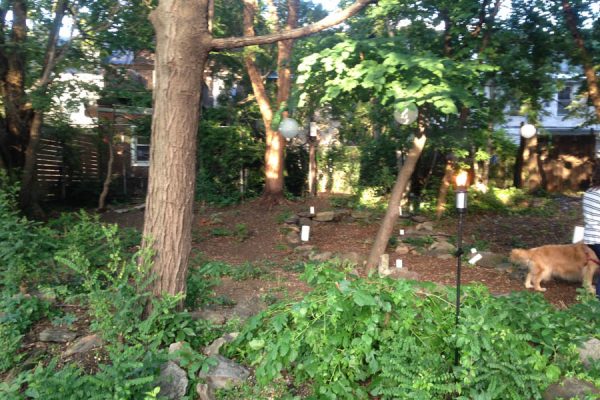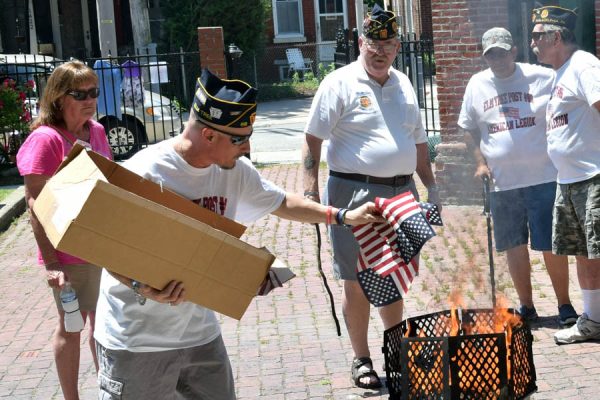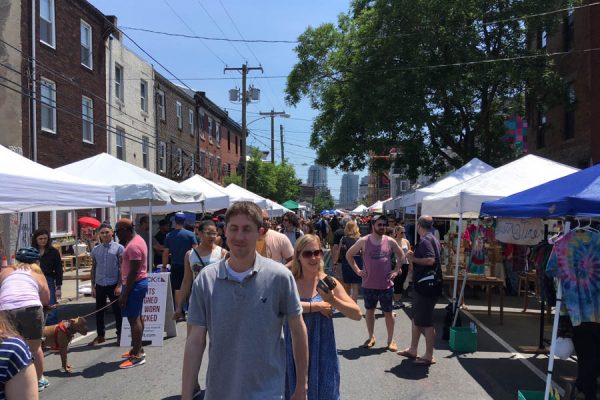Reclaiming the Riverwards
Unused land within a neighborhood is a hazard to safety, repels businesses, and poisons home value — one abandoned property within a few hundred feet on a home can bring its value down by as much as $8,000, and five vacant properties on a block brings the average home price down by $10,000.
On March 10th an information session was held in the gym at Kensington CAPA High School for community members to learn about the new Philly Land Bank, a potential solution to the city’s vacant land problem, its pilot acquisition of seventeen parcels of land on North Bodine Street just south of Cecil B. Moore, and how residents and organizations can gain control and make use of abandoned lots in their neighborhoods. Tables were set up to assist attendees with the legal details of acquiring and maintaining vacant land for community use, as well as to provide tips on subjects like growing food in an urban environment. Councilwoman Maria Quiñones-Sanchez was scheduled to speak but was ill Tuesday evening, and appearing in her stead was staffer Jennifer Kates. Kates told the crowd that the Councilwoman had made the issue of vacant land in her district her number one priority in office.
Philadelphia has been battling the adverse effects of widespread vacant land for decades, since the decline of manufacturing began in the 1960s, which precipitated a drastic reduction in the city’s population to one-half of its 1960 level by the late 1980s. Though measures undertaken by the City in the 1990s and 2000s has seen a spurt in development downtown, that growth has mostly failed to radiate from Center City, and presently around 40,000 properties in Philadelphia are listed as vacant. Our local community has its fair share of these unsightly hazards, especially the Kensington area, which has been the subject of multiple studies on the effects of and potential remedies for “blight.” The Spirit’s analysis of available property data found between 13 and 15 thousand of the 40,000 properties listed as vacant are in the River Wards.
A key failing of many redevelopment initiatives is their side-effect of ‘gentrification,’ wherein cosmetic improvements to depressed neighborhoods force many long-time, low-income residents out, because they cannot afford to make codified modifications to their property, or cannot afford to continue living in the area because of increased property value (which also ensures that no new low-income residents move in). The result is that squalor is simply shuffled around geographically, and communities are not revitalized but rather replaced. The idea of a Land Bank, as Kates put it during the information session last week, is to grant development applications according to a long-term strategic plan, with input from the community on who controls the land and how it is used, “not selling it off to the highest bidder,” she said.
Land Banks are also designed to consolidate and thus expedite the process of transferring properties from delinquent or absent owners to those who will put them to productive use, and creating a single source (a “bank”) for municipal land under the ownership of multiple agencies. Most of Philly’s vacant land is privately owned, but around 10,000 lots owned by the city and not dedicated to a pending project now sit in disuse.
Several things had to happen in order for the Land Bank, which has been pined for and planned on for many years by advocates, to be created. First the state had to pass a law allowing the creation of such entities, which happened in late 2012 when Governor Corbett Signed HR 1648, known as the Land Bank Act. Then Philadelphia City council added a new chapter to the city code, 16-500, replacing the “Councilmanic District Development Program” with the “Philadelphia Land Bank,” which was signed into law by Mayor Nutter in December of 2013. Since then the Land Bank interim board has published a strategic plan, and the City issued a request for proposals to develop the 17 parcels between 1600 and 1650 Bodine Street. The City Council also had to overhaul the zoning laws, in order to make “urban agriculture” a designated land use.
The Land Bank has established a website listing over 10,000 properties available for development, and the lion’s share are in the River Wards. The proving ground for the effort looks to be the 7th District, where Quiñones-Sanchez has aggressively pursued redevelopment efforts since she was elected to City Council in 2011, and where about one fifth of the current Land Bank properties are located.
Is there a property in your neighborhood that’s been sitting empty that you’d like to see turned into a community garden, or put to some other use for the benefit of you and your neighbors? You can start by checking the Philadelphia Land Works website and searching for the property by address. You can also browse using the map function, search by zip code, or by City Council District. The website has links to the various forms you’ll need to submit to apply to develop the property. You can’t be property-tax delinquent, and there are other disqualifying factors, but as long as you can demonstrate your plan for the prospective site and your ability to responsibly maintain the property, proposals which are deemed beneficial to the community-at-large may be eligible to buy land for closing costs alone, perhaps as little as a dollar.
Residents with small abandoned plots directly adjacent to their homes, smaller than 3,000 square feet, can apply to take control of up to two such spaces as a side yard, or perhaps even to use as a parking space. Under ideal conditions, homeowners might be able to acquire around 6,000 extra square feet of land to use as a summer garden and to park their cars, for only a couple bucks.
Selling vacant property for pennies on the dollar can actually save the City of Philadelphia millions of dollars just by sparing it the maintenance costs for land that provides no active value, and converting barren landscapes into green community spaces provides an inestimable benefit to the overall quality of life by improving everything from crime rates to storm-water runoff.
The City is not exactly erasing the cost of properties sold through the Land Bank, but instead it holds that value as a mortgage. This is its means of ensuring that it is developed as proposed. If the buyer fails to develop or maintain the land as promised, the City can call the mortgage due and collect the full cost, or foreclose on the land.
There are those who see the Land Bank as simply the rehashing of an old idea, one bound to fail. Jay McCalla, who served as Deputy Managing Director under Mayors Rendell and Street, published an opinion piece in Citified titled “INSIDE TAKE: The Land Bank is a Bad Idea.” McCalla says the Land Bank ordinance has created a redundant agency that has little hope of succeeding where others have failed with higher budgets, like his former boss John Street with the $300 million “Neighborhood Transformation Initiative.” In McCalla’s opinion the chief flaw in the Land Bank plan is that it retains the element of “Councilmanic prerogative,” in that every project must be approved by Council, and application for consideration requires demonstrating the support of the council-person in whom’s district the proposed site is located.
We can expect to see the first results on around 5,000 square feet in Olde Kensington on Bodine Street, behind a block of rowhomes and a church on the 1600 block of North 3rd. The land is now nearly completely empty, partitioned by chain-link fence in several places, and upon it sits a swing set, an abominable tarp-shrouded structure of some kind, and a row boat.
Carmen Fernandez, the block captain, told The Spirit that she had contacted Councilwoman Quiñones-Sanchez about the property, and that the residents of the block do not want the it developed for community use, but rather to continue to individually garden the lots adjacent to their own, as they have for years. Fernandez says she did not know about the Land Bank’s strategic plan, the request for proposals to develop her block, or the information session held March 10th.
“I’ve been trying to secure those lots for 34 years,” Fernandez told The Spirit when we spoke to her at her home this last weekend. “We’ve submitted over eight different applications under eight different administrations, and they’re still playing with us.”
Fernandez says she called Quiñones-Sanchez’s office two weeks ago and had been speaking with them for two weeks with no satisfactory answers.
“What we wanna do is what we do now, we plant. Not even, I wanna say, three weeks ago, I made the last salsa that I had with the cilantro and the garlic that I picked from my garden last summer. We picked over thirty pounds of beans. The neighbor next door, she picks I don’t know how many peppers and tomatoes and cucumbers. We each individually garden the lots that pertain to our properties.”
Quiñones-Sanchez’s office told The Spirit that no final decision has been made about what to do with the land behind Fernandez’s home. Staffer Jennifer Kates said via email that the purpose of the request for proposals, which closed February 20th, was to explore the possibility of building badly needed housing in an area that had been zoned as industrial, and that the Councilwoman would continue to work with the block captain and other residents on how to best use the land. Kates says they understand residents’ frustrations, and that the historical problem with the land in question is that it is made up of large, undivided parcels and not separated by the same lines as the homes on the 3rd Street. Proposals submitted are still being reviewed.







